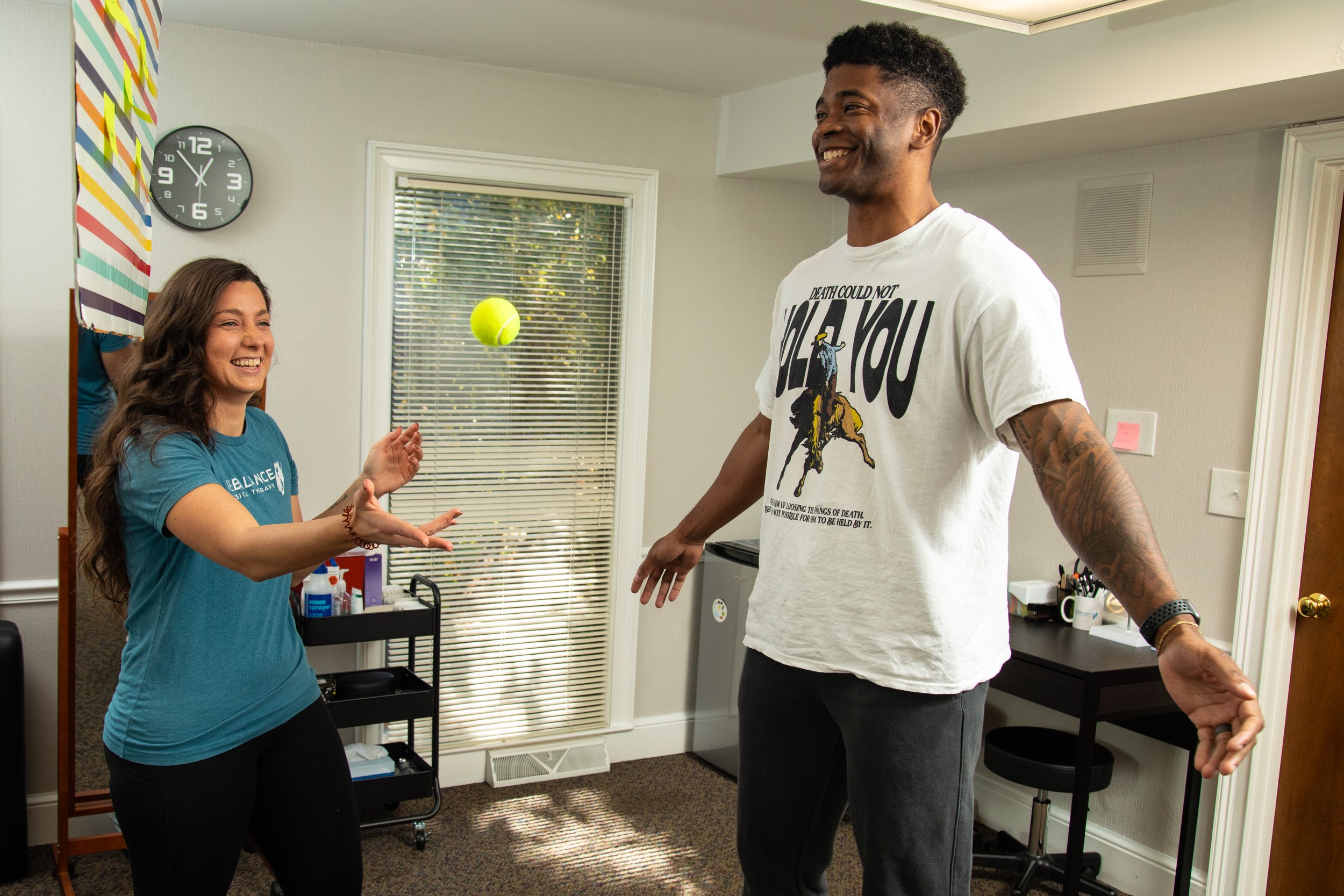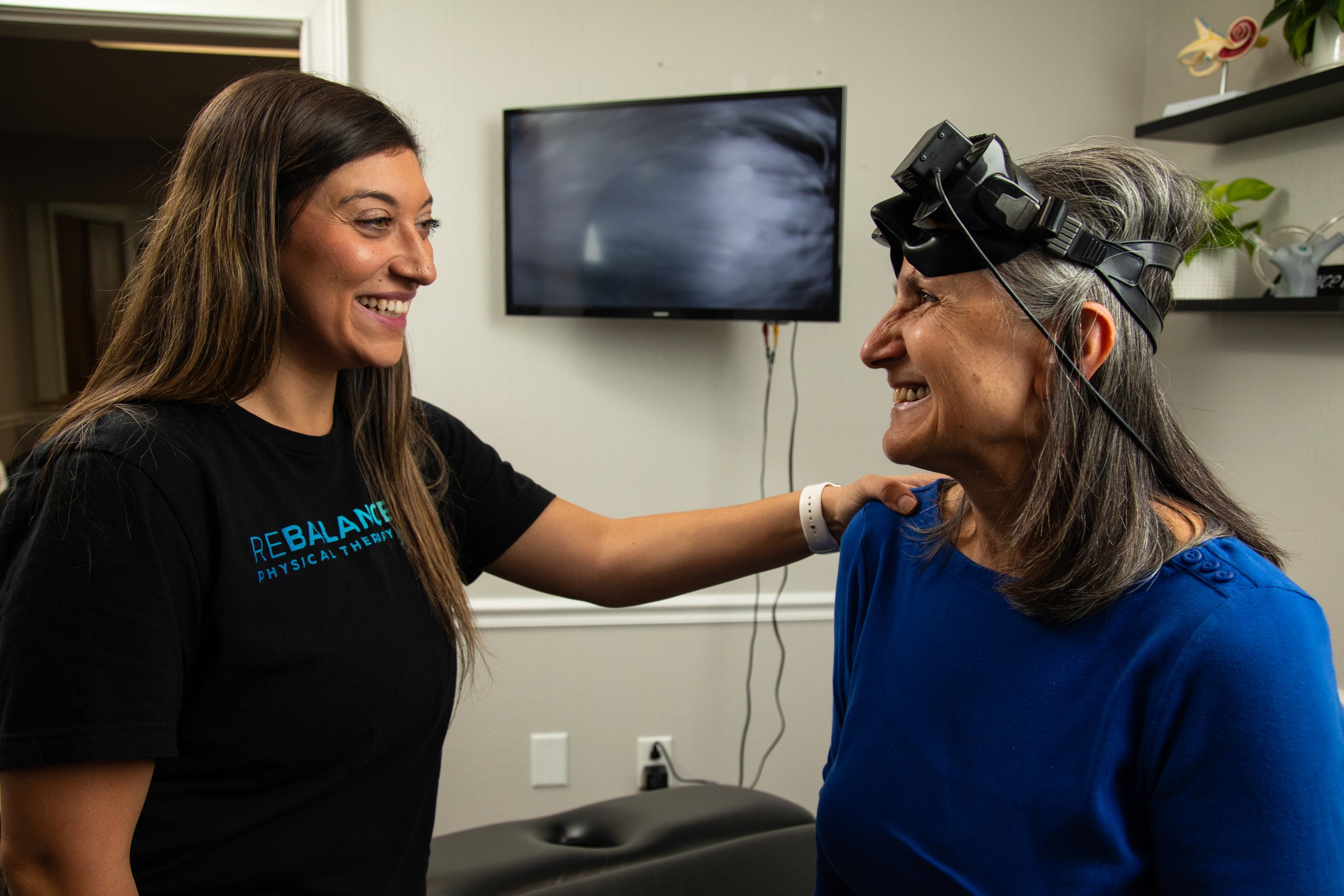
Our Services
What to expect?
An hour long session with your therapist that will ALWAYS be ONE on ONE
A thorough evaluation where you will walk away with a PLAN
Upfront costs, no hidden fees or unexpected bills
Vestibular Rehabilitation
This is perfect for those struggling with
Spinning from Vertigo
Brain fog, headaches, or difficulty keeping yours eyes focused after a head injury or concussion
Nausea, dizziness, or unsteadiness from motion sickness
IF this sounds like you, this appointment will give you the tools you need to get back to life with confidence!
Learn more about what this include down below with specific diagnoses!
Includes: Thorough examination, Day of treatment, Plan of Care, access to our exercise app
Package pricing available, just ask your therapist!
-
Vestibular Rehabilitation Therapy (VRT) is patient specific treatment based on individual presentation. VRT uses exercise based treatment such as gaze stabilization, habituation, and balance training to REBALANCE your vestibular system in relation to the brain. That is a fancy way of saying we are going to retrain how your inner ear talks to your brain and eyes! VRT aims to re-introduce you to movements in a safe way in order to return to your prior level of activity.
-
BPPV is one of the most common causes of vertigo. It is characterized by a description of “spinning” and sudden bouts of intense dizziness usually caused by specific head positions.
-
There are several different descriptions of “dizziness” that help determine the cause of your symptoms. You may feel like you are “rocking on a boat”, “light-headed”, “hazy”, “off”, more unstable with increased activity/exertion, or unable to walk through grocery stores, drive, or be in large crowds (motion sensitivity). If any of these describe you, vestibular training will be helpful for you!
-
A mismatch between firing of an individual’s vestibular systems, causing disequilibrium. VRT can be useful to help retrain the reflex between what your eyes are seeing and how your brain interprets this information, creating a REBALANCE between both firing systems.
-
Typical migraine symptoms include nausea, sensitivity to light and sound, pressure, and ringing in ears. Vestibular migraines have an addition of feeling off balance and can present with or without visual disturbance (auras).
-
There are three systems that play a role in our balance: visual, vestibular, and proprioception. When there is an abnormality in our vestibular system, the likelihood of falls significantly increases.
-
A minor traumatic brain injury caused when the brain comes into contact with the skull, most commonly from sport injuries or car accidents. Concussion symptoms include, but are not limited to, dizziness, double vision, sensitivity to sound and light, headaches, and fatigue.
-
PPPD is characterized by dizziness or unsteadiness that lasts for 3 months or more. It causes dizziness without vertigo, is provoked by external stimuli, usually occurs after a prior acute dizzy episode or stressful event, and fluctuates in severity depending on triggers.
1 hour Group Training
Our tailored group training is designed to enhance the vestibular system, improve hand-eye coordination, sharpen quick head movements, and master lightning-fast turns, giving athletes the competitive edge they need to excel in sports like hockey, soccer, gymnastics, baseball, tennis, and golf.
But that's not all – we also offer 1 hour group training sessions for sports clubs, teams, and organizations, providing targeted exercises and personalized guidance to elevate performance and foster team cohesion.
Whether you're rehabilitating from an injury or aiming to enhance your game, our expert therapists are here to support you every step of the way.
Contact us today to schedule your consultation and take your athletic journey to new heights with Rebalance Physical Therapy!
-
Any sport with rotation. Hockey, Soccer, Gymnastics, Tennis, Football and more!
-
We will come and train your team/athletes for 1 hour through specialized drills tailored to the movements your sport demands. This typically involves neuro-cognitive drills, hand/eye coordination, quick head turns to activate the vestibular system, and more.
Perfect for groups of 30-40 players.
-
Players with a history of concussion will feel symptoms with this training. This is because they need this training the most! It should have been included in their rehab, however it is often missed. This may show that your player with history of concussions may need individualized training that we provide to make sure they are safe and playing their best on the field.
Right Eye Assessments
We are proud to offer a more comprehensive vision exam using advanced, state-of-the-art eye-tracking technology.
The RightEye system enables our doctors to pinpoint functional vision and brain health issues, identify the root cause of reading problems, and improve athletic performance. In just 5 minutes, this proven, patented technology measures visual skills in ways that a standard eye exam cannot — enabling us to diagnose and treat underlying vision issues that affect our patients’ quality of life.
-
Your two eyes and brain must all work together to navigate the world. It’s this connection that makes up your dynamic vision. A standard eye exam, however, only checks your eyes’ physical health and ability to focus on stationary objects — it doesn’t measure critical dynamic vision skills such as eye movement and coordination. Signs that you may have a functional vision problem include:
Difficulty concentrating
Rereading or skipping lines of print
Short attention span
Poor reading comprehension
Poor coordination or balance
Slow completion of work
Previous brain trauma (concussions, strokes)
Loss of interest in reading
Frequent headaches
RightEye Dynamic Vision is a 5-minute, non-invasive test performed at our offices that could diagnose a dynamic vision issue and set you on a path to improvement
-
In sports, almost 80% of perceptual input is visual. But even 20/20 vision does not mean athletes are performing at their peak. Objects don’t just sit there. They move. Fast. Regular eye exams may reveal that you can see clearly, but they can’t tell how well you differentiate where a ball is in space, how fast it’s traveling, or if it’s changing direction.
That’s why we offer vision testing designed specifically for athletes. Using state-of-the-art eye-tracking technology, we can measure the specific vision skills that affect reflexes and hand-eye coordination, including:
Eye movement speed
Processing speed
Dynamic visual focus
Smooth visual pursuit
Simple reaction time
Choice reaction time
Binocular vision skills
Visual concentration
Contrast sensitivity
RightEye Sports Vision EyeQ measures and analyzes your eye movement, brain processing and reaction time against peers, amateurs and pro athletes. When the report identifies opportunities for improvement, our optometrists will customize a plan for you, built from an online library of 150+ training drills. And in just a few weeks, you could be upping your game.
-
One in four children has a vision problem that affects learning — a vision problem that is often misinterpreted as disinterest, sleepiness, dyslexia or ADHD. Eyesight (the ability to receive input through the eye) is not the same as vision (the ability to understand what that input is). Recognizing this distinction has monumental implications. Even a child with 20/20 eyesight can have a vision issue at the core of their learning problem.
To complicate matters, vision-related learning problems share the same symptoms as countless learning disability diagnoses, including:
Difficulty concentrating
Rereading or skipping lines of print
Letter reversals
Difficulty recognizing words
Short attention span
Poor reading comprehension
Poor handwriting
Slow completion of work
Loss of interest in reading
But thanks to RightEye’s Reading Assessment test, our doctors are able to expose vision and brain health in ways not possible from standard eye tests, gifting you with the opportunity to change your child’s life forever.
How to prepare?
Fill out the forms to the best of your ability prior to appointment- this will help when we are painting the full picture!
Wear athletic clothes that you are comfortable moving around in
Be ready to be an active participant in the process!
Questions? Click the link below to leave us a message!




